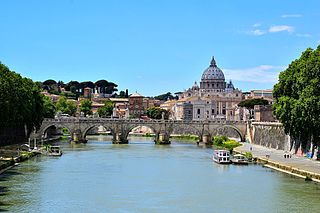
The Tiber is the third-longest river in Italy and the longest in Central Italy, rising in the Apennine Mountains in Emilia-Romagna and flowing 406 km (252 mi) through Tuscany, Umbria, and Lazio, where it is joined by the River Aniene, to the Tyrrhenian Sea, between Ostia and Fiumicino. It drains a basin estimated at 17,375 km2 (6,709 sq mi). The river has achieved lasting fame as the main watercourse of the city of Rome, which was founded on its eastern banks.

Vatican City, officially the Vatican City State, is a landlocked sovereign country, city-state, microstate, and enclave within Rome, Italy. It became independent from Italy in 1929 with the Lateran Treaty, and it is a distinct territory under "full ownership, exclusive dominion, and sovereign authority and jurisdiction" of the Holy See, itself a sovereign entity under international law, which maintains the city-state's temporal power and governance, diplomatic, and spiritual independence. The Vatican is also a metonym for the pope, the city-state's and worldwide Catholic Church government Holy See, and Roman Curia.
The Vatican City State is a neutral nation, which has not engaged in any war since its formation in 1929 by the Lateran Treaty. It has no formal military compact or agreement with neighbouring Italy, although responsibility for defending the Vatican City from an international aggressor is likely to lie primarily with the Italian Armed Forces. When presenting the Lateran Treaty to the Italian parliament in 1929, Benito Mussolini declared: "It is evident that we [the Italian state] will be the necessary guarantors of this neutrality and inviolability [of Vatican City], since, in the remote hypothesis someone wanted to hurt her, he would first have to violate our territory." Although the Vatican City state has never been at war, it was exposed, together with properties of the Holy See in Rome, to bombings during World War II.

The Pontifical Croatian College of St. Jerome is a Catholic college, church and a society in the city of Rome intended for the schooling of South Slav clerics. It is named after Saint Jerome. Since the founding of the modern college in 1901, it has schooled 311 clerics from all bishoprics of Croatia.
The papal household or pontifical household, called until 1968 the Papal Court, consists of dignitaries who assist the pope in carrying out particular ceremonies of either a religious or a civil character.

The Annuario Pontificio is the annual directory of the Holy See of the Catholic Church. It lists the popes in chronological order and all officials of the Holy See's departments. It also provides names and contact information for all cardinals and bishops, the dioceses, the departments of the Roman Curia, the Holy See's diplomatic missions abroad, the embassies accredited to the Holy See, the headquarters of religious institutes, certain academic institutions, and other similar information. The index includes, along with all the names in the body of the book, those of all priests who have been granted the title of "Monsignor".
The Prefecture of the Papal Household is the office in charge of the Papal Household, a section of the Roman Curia that comprises the Papal Chapel and the Papal Family.

Poggio Mirteto is a comune (municipality) is situated in the Tiber Valley area of the region of Latium, Italy. Administratively Poggio Mirteto is in the province of Rieti and geographically this municipality is about 45 kilometres (28 mi) northeast of Rome and about 20 kilometres (12 mi) southwest of Rieti.
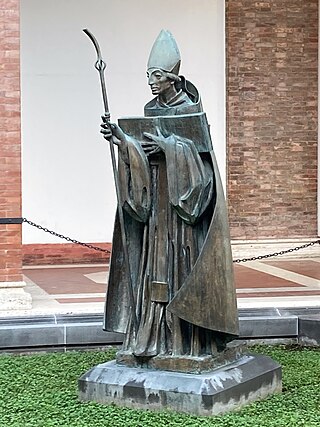
Sant'Anselmo all'Aventino is a complex located on the Piazza Cavalieri di Malta Square on the Aventine Hill in Rome's Ripa rione and overseen by the Benedictine Confederation and the Abbot Primate. The Sant'Anselmo complex, also known as the "Primatial Abbey of Sant'Anselmo" because it is the residence of the Abbot Primate, consists of: an ecclesiastical residential college known as the "College of Sant'Anselmo" ; a university known as the "Pontifical Athenaeum of Saint Anselm" ; the "Church of Sant'Anselmo" ; and the curial headquarters of the "Benedictine Confederation" and Abbot Primate. The complex and associated institutions are named in honor of the Benedictine monk Saint Anselm of Canterbury.

Ostia Antica is the 35th zona of Rome, Italy, four kilometers away from the coast. It is identified by the initials Z. XXXV and it is distinct from Ostia. Ostia Antica belongs to Municipio X.
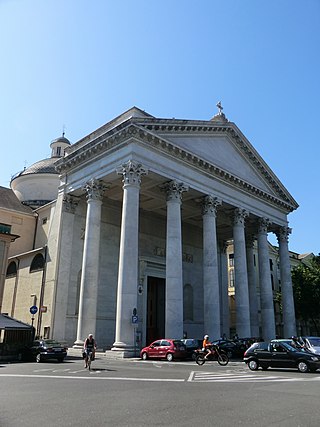
The Diocese of Chiavari is a Latin diocese of the Catholic Church in Liguria, northern Italy. It was created on 3 December 1892 by Pope Leo XIII in the Bull Romani Pontifices. It is a suffragan of the Archdiocese of Genoa.

Porta Portese is an ancient city gate, located at the end of Via Portuense, where it meets Via Porta Portese, about a block from the banks of the Tiber in the southern edge of the Rione Trastevere of Rome, Italy.
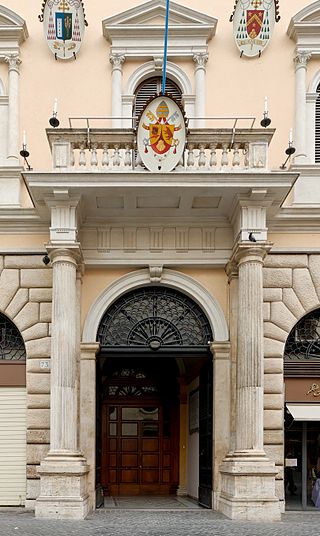
The Roman Colleges, also referred to as the Pontifical Colleges in Rome, are institutions established and maintained in Rome for the education of future ecclesiastics of the Catholic Church. Traditionally many were for students of a particular nationality. The colleges are halls of residence in which the students follow the usual seminary exercises of piety, study in private, and review the subjects treated in class. In some colleges there are special courses of instruction but the regular courses in philosophy and theology are given in a few large central institutions, such as Pontifical Urbaniana University, the Pontifical Gregorian University, the Pontifical Lateran University, and the Pontifical University of Saint Thomas Aquinas, Angelicum.
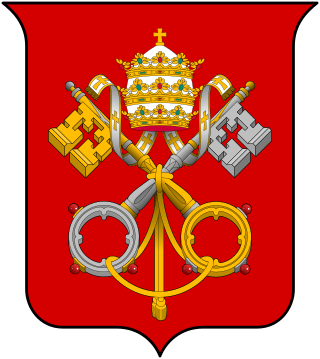
The Diocese of Rome, also called the Vicariate of Rome, is a Latin diocese of the Catholic Church under the direct jurisdiction of the Pope, who is Bishop of Rome and hence the supreme pontiff and head of the worldwide Catholic Church. As the Holy See, the papacy is a sovereign entity with diplomatic relations, and civil jurisdiction over the Vatican City State located geographically within Rome. The Diocese of Rome is the metropolitan diocese of the province of Rome, an ecclesiastical province in Italy. According to Catholic tradition, the first bishop of Rome was Saint Peter in the first century. The incumbent since 13 March 2013 is Pope Francis.

Municipio I is an administrative subdivision of the municipality of Rome, encompassing the centre of the city.
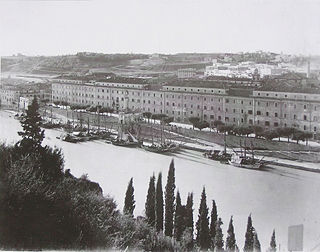
Porto di Ripa Grande was the river port of Rome, just downstream the former Pons Sublicius, where the wares, going up and down the Tiber towards the dock of Fiumicino, were handled. The building of the muraglioni has erased its existence and function, just keeping a trace in the toponymy and in the two ramps giving access to the quay of the river.

The following outline is provided as an overview of and topical guide to Rome:

Tor San Michele, also known as Forte San Michele, is a coastal watchtower in Ostia, a frazione of the Municipality of Rome (Italy), rising near the mouth of the Tiber.

Immacolata Concezione was a screw corvette of The Papal Navy, built in the English shipyards of Thames Iron Shipbuilding Co. in Blackwall. It was delivered to Civitavecchia in 1859.

















